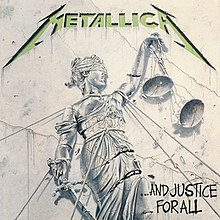...And Justice for All (album)
| …And Justice for All | ||||
|---|---|---|---|---|
 |
||||
| Studio album by Metallica | ||||
| Released | August 25, 1988 | |||
| Recorded | January 28–May 1, 1988 | |||
| Studio | One on One Recording Studios in Los Angeles, California | |||
| Genre | ||||
| Length | 65:29 | |||
| Label | Elektra | |||
| Producer |
|
|||
| Metallica chronology | ||||
|
||||
| Singles from …And Justice for All | ||||
|
||||
| Professional ratings | |
|---|---|
| Review scores | |
| Source | Rating |
| AllMusic | |
| Chicago Tribune | |
| Encyclopedia of Popular Music | |
| Metal Forces | 10/10 |
| Q | |
| Rock Hard | 9.5/10 |
| Rolling Stone | |
| The Rolling Stone Album Guide | |
| Sputnikmusic | 2/5 |
| The Village Voice | C+ |
…And Justice for All is the fourth studio album by American heavy metal band Metallica, released on August 25, 1988, by Elektra Records. It was the band's first studio album to feature bassist Jason Newsted after the death of Cliff Burton in 1986. …And Justice for All is musically progressive, with long and complex songs, fast tempos, and few verse-chorus structures. The album is noted for its sterile production, which producer Flemming Rasmussen attributed to his absence during the mixing process. The lyrics feature themes of political and legal injustice seen through the prisms of censorship, war, and nuclear brinkmanship.
The album's front cover, designed by Stephen Gorman on a scheme by James Hetfield and Lars Ulrich, features a representation of Lady Justice, bound by ropes, with one breast bare and its scales tipping toward one plate filled with money. The phrase "…And Justice for All" appears spray-painted in the lower right corner. The album title is derived from the American Pledge of Allegiance. Three songs from the album were released as singles: "Harvester of Sorrow", "Eye of the Beholder", and "One", while the title track was released as a promotional single.
…And Justice for All was acclaimed by music critics. It was included in The Village Voice's annual Pazz & Jop critics' poll of the year's best albums, and the single "One" earned Metallica its first Grammy Award for Best Metal Performance in 1990. The group's best-selling album at the time, it was the first underground metal album to achieve chart success in the United States. The album was certified 8× platinum by the Recording Industry Association of America (RIAA) in 2003 for shipping eight million copies in the US, making it Metallica's second-best-selling album in the country.
...
Wikipedia
